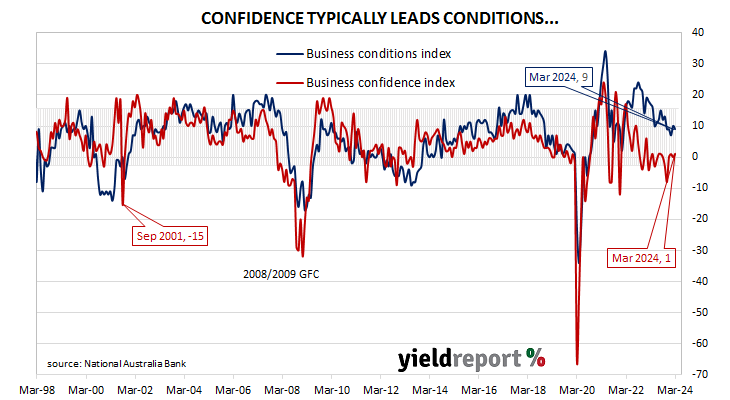Summary: Business conditions deteriorate slightly in March; business pessimism eases slightly, confidence index still below average; continues the trend of above-average activity indicators alongside below-average confidence; ACGB yields move lower; rate-cut expectations firm; tentative signs supply, demand coming into balance; capacity utilisation rate declines, still at elevated level.
NAB’s business survey indicated Australian business conditions were robust in the first half of 2018, with a cyclical-peak reached in April of that year. Readings from NAB’s index then began to slip and forecasts of a slowdown in the domestic economy began to emerge in the first half of 2019 as the index trended lower. It hit a nadir in April 2020 as pandemic restrictions were introduced but then improved markedly over the next twelve months and has subsequently remained at robust levels.
According to NAB’s latest monthly business survey of around 400 firms conducted in the last two weeks of March, business conditions slipped a touch, albeit to a level which is still above the long-term average. NAB’s conditions index registered 9 points, down 1 point from February’s reading.
Conversely, business confidence improved slightly. NAB’s confidence index inched up from February zero reading, a reading which is below the long-term average. Typically, NAB’s confidence index leads the conditions index by one month, although some divergences have appeared from time to time.
“Business conditions and confidence were little changed in March, continuing the trend of above-average activity indicators alongside below-average confidence that has defined the NAB Business Survey for much of the past year,” said NAB Chief Economist Alan Oster.
Commonwealth Government bond yields moved uniformly lower on the day. By the close of business, 3-year, 10-year and 20-year ACGB yields had all lost 3bps to 3.70%, 4.18% and 4.48% respectively.
In the cash futures market, expectations regarding rate cuts in the next twelve months firmed a little. At the end of the day, contracts implied the cash rate would remain close to the current rate for the next few months and average 4.30% through May and 4.29% in June. However, August contracts implied a 4.215% average cash rate, November contracts implied 4.075%, while May 2025 contracts implied 3.83%, 50bps less than the current rate.
“There are tentative signs that supply and demand are coming into better balance with capacity utilisation continuing to ease albeit gradually and from a high level,” Oster added. “In line with this, the month saw some modest easing in the pace of labour and materials cost growth but both remain elevated, and retail price growth also remained strong at 1.3% in quarterly equivalent terms.”
NAB’s measure of national capacity utilisation declined again, this time from February’s reading of 83.4% to 83.2%, a level which is still quite elevated from a historical perspective. Seven of the eight sectors of the economy were reported to be operating at or above their respective long-run averages.
Capacity utilisation is generally accepted as an indicator of future investment expenditure and it also has a strong inverse relationship with Australia’s unemployment rate.



